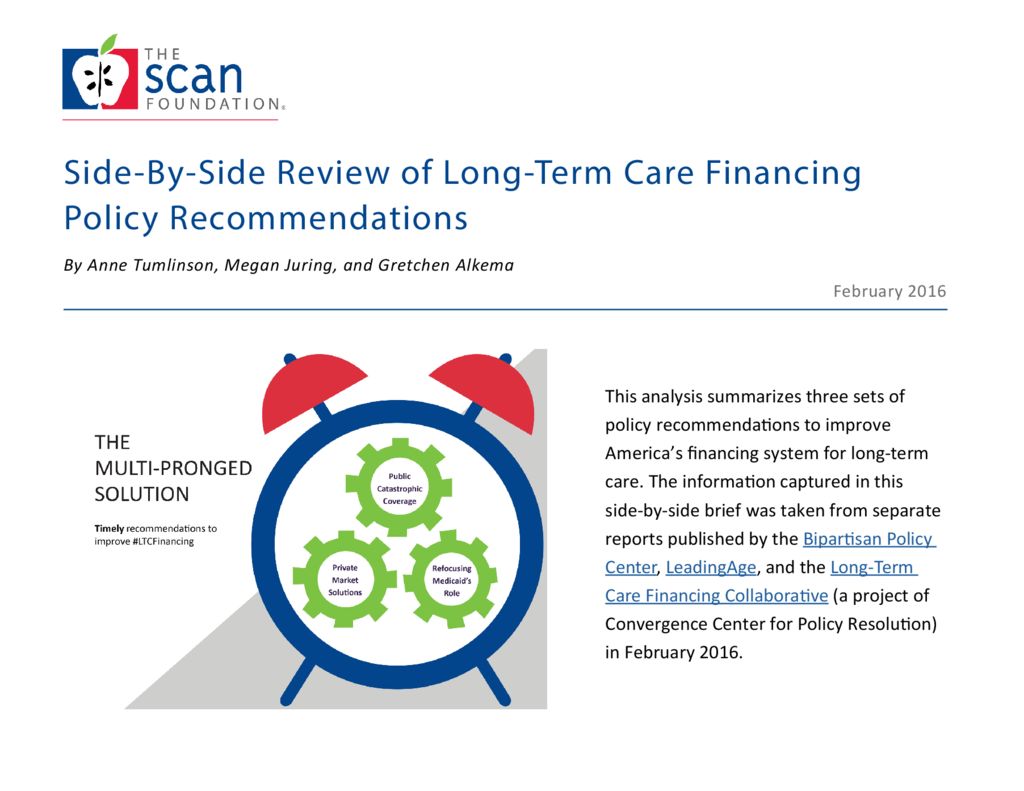Side-By-Side Review of Long-Term Care Financing Policy Recommendations
summary
Last year, modeling efforts distilled various options to improve America’s financing system for long-term care. This month, three organizations – the Bipartisan Policy Center, LeadingAge, and the Long-Term Care Financing Collaborative – released related policy recommendations. This analysis identifies common themes and notes where the recommendations differ in perspective.
Date Updated: 02/22/2016Introduction
Half of all Americans turning 65 today will one day find themselves needing a high level of help with basic daily activities, such as walking, eating, bathing, and getting out of bed. The average American will face substantial long-term care (LTC) costs in old age—an estimated $91,000 for men and $182,000 for women. These amounts can be much higher depending on the number of years individuals need high levels of help. While 19 percent of older adults will live only one year with this high level of need, 14 percent will experience need this for five or more years. Older adults with longer periods of high need usually end up paying for long-term services and supports (LTSS) through significant amounts of out-of-pocket spending. Many also rely on unpaid family care or go without needed care.1 Once a person’s savings has been exhausted, LTSS costs are then covered by Medicaid.
Over the past two years The SCAN Foundation, LeadingAge, and AARP jointly funded research by the Urban Institute and Milliman, Inc. to analyze the impact of a broad array of policy options to finance LTC using the most recent demographic information on need, combined with data on public and private coverage costs. The jointly-funded research culminated in November 2015 with the publication of a HealthAffairs paper and two research reports. Using this new modeling tool, policymakers and stakeholders can now compare a variety of options for improving individuals’ ability to pay for their LTSS needs. Some of the options analyzed focus on insuring against the costs of this high level of need for limited periods of time, while others explore coverage for catastrophic lifetime risk. The modeling work provides an opportunity to compare different designs across consistent measures, such as likely participation rates, affordability, estimated out-of-pocket spending, and the effect on Medicaid spending…
Download the publication for all visuals and complete references.
Continue Reading
This policy brief provides background on the historical development of benefit eligibility triggers in the private long-term care insurance market. Understanding how these triggers came into being can provide important information to those charged with implementing the CLASS Plan.
This policy brief provides information about how long-term care insurers implement benefit eligibility triggers in the private insurance market. The way in which companies have operationalized benefit eligibility triggers can inform the development of regulations for the CLASS Plan.
This policy brief provides information on the benefit eligibility assessment process in the private long-term care insurance industry. It focuses on how long-term care insurers use the information in the adjudication process, who is involved in the process, and how activities of daily living and cognition are assessed.


